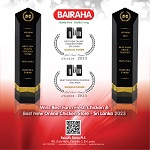Education
New Helicopter wing structure for Airbus Helicopters’ Rotorcraft Demonstrator Launched at Paris Air Show

The University’s Advanced Wing Structure for Rotorcraft Additional Lift (ASTRAL) Project is run in collaboration with GE Aviation, with Airbus Helicopters as the Work Area Leader. It is funded by the EU through the Clean Sky 2 (CS2) Joint Undertaking. Clean Sky is the largest European research programme which develops innovative, cutting edge technology aimed at reducing CO2 and NOx emissions and noise levels produced by aircraft, and improving the competitiveness of European industry.
The ASTRAL Project forms an important element in the drive to achieve lower emissions and has led to this design of a more efficient helicopter wing with optimised control surfaces and systems to meet the objectives of CS2.
These factors will make the operational model ideal for a wide range of missions which call for increased speed and efficiency such as medical evacuations, search and rescue operations, as well as public services, commercial air transport and private aviation.
In addition, the innovative wing has been designed with novel manufacturing processes which make it possible to manufacture complex products like these in high labour cost countries.
Tomasz Krysinski, Head of Research and Innovation at Airbus Helicopters, commented, “We are extremely happy to have the University of Nottingham among our partners for the new Racer High Speed Rotorcraft Demonstrator. The University’s world-leading expertise and resources in engineering, advanced manufacturing and materials, and aerospace technology, have given us a leading edge to ensure we provide an outstanding high speed helicopter to our customers, which meets exacting standards of performance, quality and safety.”
Speaking about IfAM’s involvement in the project, Professor Svetan Ratchev, Director of IfAM and the ASTRAL project coordinator, said, “We are thrilled to be part of this pioneering programme to deliver an advanced aircraft platform that will ensure competitive and green aviation and deliver important high value manufacturing jobs in Europe. Working in close collaboration with Airbus Helicopters and GE Aviation, the University of Nottingham team is uniquely positioned to contribute to the development of both the groundbreaking wing design and manufacturing technologies for the new Racer High Speed Rotorcraft.”
Paul Mandry, Engineering Project Lead for GE Aviation, added, “GE Aviation is proud to collaborate with the University of Nottingham to support the launch of Airbus Helicopters’ new Racer High Speed Rotorcraft Demonstrator. The ASTRAL project leverages the expertise of GE Aviation’s Hamble team in aircraft structures, enabling us to contribute to achievements in aircraft performance improvements. This is critical to increasing affordability in air travel and meeting Paul Mandry, Engineering Project Lead for GE Aviation, added, “GE Aviation is proud to collaborate with the University of Nottingham to support the launch of Airbus Helicopters’ new Racer High Speed Rotorcraft Demonstrator. The ASTRAL project leverages the expertise of GE Aviation’s Hamble team in aircraft structures, enabling us to contribute to achievements in aircraft performance improvements. This is critical to increasing affordability in air travel and meeting stringent environmental targets that affect almost every aspect of the overall performance of the air transportation system.”
The research is expected to set the standard for aerodynamic efficiency in high speed helicopters. It will also bring about a host of benefits including lighter, high performance, more affordable and easier to fabricate wing structures for aircraft. These benefits will improve resource-efficiency and therefore have a positive ecological impact.
The ASTRAL Project has a strong potential for long-term industrial and commercial exploitation of its results. Beyond the end of the project, the Racer demonstrator will be used as a fundamental element to accelerate the transfer of the key wing design, manufacture and assembly technologies to the industry at large.




















































